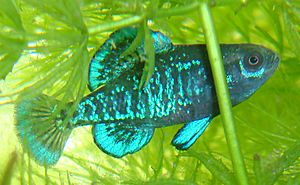Gulf Coast pygmy sunfish facts for kids
Quick facts for kids Gulf Coast pygmy sunfish |
|
|---|---|
 |
|
| Elassoma gilberti male in breeding colors | |
| Conservation status | |
| Scientific classification |
The Gulf Coast pygmy sunfish (scientific name: Elassoma gilberti) is a tiny fish found only in Florida, United States. It is a type of pygmy sunfish. This small fish can grow to about 2.5 centimeters (1 inch) long.
Elassoma gilberti looks a lot like its close relative, E. okefenokee. But there are a few ways to tell them apart. E. gilberti usually has four small openings near its cheek, while E. okefenokee usually has three. Also, E. gilberti typically has seven rays (or supports) in its anal fin, but E. okefenokee usually has eight. Female E. gilberti often have a blue patch of color behind their eye, which female E. okefenokee do not.
Where They Live
This pygmy sunfish lives in northwestern Florida and southwestern Georgia. You can find them in rivers and streams that flow into the Gulf of Mexico. This includes areas from the Waccasassa River west to Choctawhatchee Bay.
Both E. gilberti and E. okefenokee like to live among thick water plants and fallen leaves. They hide there and look for food. They mostly eat tiny insects, small crustaceans (like tiny shrimp), and worms.
How They Reproduce
Gulf Coast pygmy sunfish can breed in many different water conditions. Males need a spot with lots of real or fake plants to make their territory. Each male claims a space about one cubic foot in size.
The males spend their time swimming around their territory. They do a special dance to get the females' attention. When dancing, they wiggle their top, bottom, and tail fins. This shows off their bright blue, shiny colors. Then, they suddenly stop and stay perfectly still for a few seconds. After this pause, they start dancing again, often moving up and down. They do this to encourage females to come into their plant clumps to lay eggs.
Females swim into and out of the males' territories to lay their eggs. After the eggs are laid, the male guards the eggs. He chases away any other females or males that come too close.
The eggs usually hatch in about three to four days. Once the eggs hatch, the male stops guarding the area. He then becomes ready to breed again.


